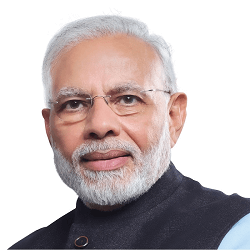प्रधानमंत्री नरेंद्र मोदी/About Narendra Modi/Prime-Minister
Tags : Author : Updated : 👁 618

Narendra Modi
Name: Narendra Damodardas Modi
Born: 17 September 1950 (age 73 years), Vadnagar
Father: Damodardas Mulchand Modi (1915–1989)
Mother: Hiraben Modi (1923–2022)
Spouse: Jashodaben Modi (1968-NOW)
Party: Bharatiya Janata Party
Awards: Order of the Distinguished Rule of Izzuddin, Legion of Honour, Seoul Peace Prize, CNN-IBN Indian of the Year
Full name: Narendra Damodardas Modi
Education: Gujarat University (1983), School of Open Learning, University of Delhi (1978)
Organizations founded: Ayushman Bharat Digital Mission, International Solar Alliance
Early life and education
Narendra Damodardas Modi was born on 17 September 1950 to a Gujarati Hindu family of grocers in Vadnagar, Mehsana district, Bombay State (present-day Gujarat). He was the third of six children born to Damodardas Mulchand Modi (Father) (c. 1915–1989) and Hiraben Modi (Mother) (1923–2022).
Modi completed his higher secondary education in Vadnagar in 1967. In 1978, Modi received a Bachelor of Arts (BA) degree in political science from the School of Open Learning at the Delhi University. In 1983, he received a Master of Arts (MA) degree in political science from Gujarat University, graduating with a first class as an external distance learning student. There is a controversy surrounding the authenticity of his BA and MA degrees.
Chief Minister of Gujarat (2001–2014)
In 2001, Keshubhai Patel's health was failing and the BJP lost a few state assembly seats in by-elections. Allegations of abuse of power, corruption and poor administration were made, and Patel's standing had been damaged by his administration's handling of the earthquake in Bhuj in 2001. The BJP national leadership sought a new candidate for the chief ministership, and Modi, who had expressed misgivings about Patel's administration, was chosen as a replacement. Advani did not want to ostracise Patel and was concerned about Modi's lack of experience in government. Modi declined an offer to become Patel's deputy chief minister, telling Advani and Atal Bihari Vajpayee he was "going to be fully responsible for Gujarat or not at all". On 3 October 2001, Modi replaced Patel as Chief Minister of Gujarat with the responsibility of preparing the BJP for the upcoming December 2002 election. On 7 October, Modi was sworn in and he entered the Gujarat state legislature on 24 February 2002 after winning a by-election in Rajkot II constituency, defeating Ashwin Mehta of the INC.
Prime Minister (2014–present)
The premiership of Narendra Modi began on 26 May 2014 with his swearing-in as the Prime Minister of India at the Rashtrapati Bhavan. He became the 14th Prime Minister of India, succeeding Manmohan Singh of the Indian National Congress. Modi's first cabinet consisted of 45 ministers, 25 fewer than the previous United Progressive Alliance government. 21 ministers were added to the council of ministers on 9 November 2014.
In 2019, he was elected as the prime minister of India for the second time and sworn in at the Rashtrapati Bhavan on 30 May 2019. His second cabinet consisted of 54 ministers and initially had 51 ministers, which was expanded to 77 ministers during a reshuffle on 7 July 2021. His premiership has, to a considerable extent, practiced high command culture.
(After the Bharatiya Janata Party-led National Democratic Alliance (NDA) won a landslide in the 2014 Lok Sabha election, Modi was sworn in as Prime Minister (PM) of India on 26 May 2014, becoming the first Indian PM to be born after the country's independence from the British Empire in 1947. Modi's second term as PM began in 2019 following the NDA's 2019 Lok Sabha election win. On 6 December 2020, he became the fourth-longest-serving Prime Minister of India and the longest-serving non-Congress prime minister.)




